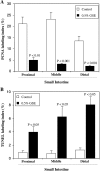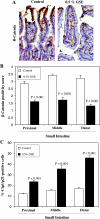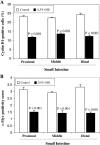Dietary feeding of grape seed extract prevents intestinal tumorigenesis in APCmin/+ mice
- PMID: 20072658
- PMCID: PMC2805888
- DOI: 10.1593/neo.91718
Dietary feeding of grape seed extract prevents intestinal tumorigenesis in APCmin/+ mice
Abstract
Chemopreventive effects and associated mechanisms of grape seed extract (GSE) against intestinal/colon cancer development are largely unknown. Herein, we investigated GSE efficacy against intestinal tumorigenesis in APC(min/+) mice. Female APC(min/+) mice were fed control or 0.5% GSE (wt/wt) mixed AIN-76A diet for 6 weeks. At the end of the experiment, GSE feeding decreased the total number of intestinal polyps by 40%. The decrease in polyp formation in the small intestine was 42%, which was mostly in its middle (51%) and distal (49%) portions compared with the proximal one. GSE also decreased polyp growth where the number of polyps of 1 to 2 mm in size decreased by 42% and greater than 2 mm in size by 71%, without any significant change in polyps less than 1 mm in size. Immunohistochemical analyses of small intestinal tissue samples revealed a decrease (80%-86%) in cell proliferation and an increase (four- to eight-fold) in apoptosis. GSE feeding also showed decreased protein levels of cyclooxygenase-2 (COX-2) (56%-64%), inducible nitric oxide synthase (iNOS) (58%-60%), and beta-catenin (43%-59%) but an increased Cip1/p21-positive cells (1.9- to 2.6-fold). GSE also decreased cyclin D1 and c-Myc protein levels in small intestine. Together, these findings show the chemopreventive potential of GSE against intestinal polyp formation and growth in APC(min/+) mice, which was accompanied with reduced cell proliferation and increased apoptosis together with down-regulation in COX-2, iNOS, beta-catenin, cyclin D1, and c-Myc expression, but increased Cip1/p21. In conclusion, the present study suggests potential usefulness of GSE for the chemoprevention of human intestinal/colorectal cancer.
Figures





Similar articles
-
Inhibition of intestinal adenoma formation in APC(Min/+) mice by Riccardin D, a natural product derived from liverwort plant Dumortiera hirsuta.PLoS One. 2012;7(3):e33243. doi: 10.1371/journal.pone.0033243. Epub 2012 Mar 14. PLoS One. 2012. PMID: 22432006 Free PMC article.
-
Dietary-feeding of grape seed extract prevents azoxymethane-induced colonic aberrant crypt foci formation in fischer 344 rats.Mol Carcinog. 2010 Jul;49(7):641-52. doi: 10.1002/mc.20643. Mol Carcinog. 2010. PMID: 20564341 Free PMC article.
-
Chemoprevention of intestinal tumorigenesis in APCmin/+ mice by silibinin.Cancer Res. 2010 Mar 15;70(6):2368-78. doi: 10.1158/0008-5472.CAN-09-3249. Epub 2010 Mar 9. Cancer Res. 2010. PMID: 20215518 Free PMC article.
-
Chemoprevention of colon cancer by Korean food plant components.Mutat Res. 2003 Feb-Mar;523-524:99-107. doi: 10.1016/s0027-5107(02)00325-1. Mutat Res. 2003. PMID: 12628507 Review.
-
Calcium, calcium-sensing receptor and colon cancer.Cancer Lett. 2009 Mar 8;275(1):9-16. doi: 10.1016/j.canlet.2008.07.001. Epub 2008 Aug 23. Cancer Lett. 2009. PMID: 18725175 Review.
Cited by
-
Sicilian pistachio (Pistacia vera L.) nut inhibits expression and release of inflammatory mediators and reverts the increase of paracellular permeability in IL-1β-exposed human intestinal epithelial cells.Eur J Nutr. 2015 Aug;54(5):811-21. doi: 10.1007/s00394-014-0760-6. Epub 2014 Sep 5. Eur J Nutr. 2015. PMID: 25190035
-
Familial adenomatous polyposis in pediatrics: natural history, emerging surveillance and management protocols, chemopreventive strategies, and areas of ongoing debate.Fam Cancer. 2016 Jul;15(3):477-85. doi: 10.1007/s10689-016-9905-5. Fam Cancer. 2016. PMID: 27056662
-
Procyanidin B2 3,3(″)-di-O-gallate, a biologically active constituent of grape seed extract, induces apoptosis in human prostate cancer cells via targeting NF-κB, Stat3, and AP1 transcription factors.Nutr Cancer. 2014;66(4):736-46. doi: 10.1080/01635581.2013.783602. Epub 2013 Nov 5. Nutr Cancer. 2014. PMID: 24191894 Free PMC article.
-
Grape compounds suppress colon cancer stem cells in vitro and in a rodent model of colon carcinogenesis.BMC Complement Altern Med. 2016 Aug 9;16:278. doi: 10.1186/s12906-016-1254-2. BMC Complement Altern Med. 2016. PMID: 27506388 Free PMC article.
-
Java brucea and Chinese herbal medicine for the treatment of cholesterol granuloma in the suprasellar and sellar regions: A case report and literature review.Medicine (Baltimore). 2017 Feb;96(5):e5930. doi: 10.1097/MD.0000000000005930. Medicine (Baltimore). 2017. PMID: 28151875 Free PMC article.
References
-
- Sesink AL, Termont DS, Kleibeuker JH, Van Der Meer R. Red meat and colon cancer: dietary haem, but not fat, has cytotoxic and hyperproliferative effects on rat colonic epithelium. Carcinogenesis. 2000;21:1909–1915. - PubMed
-
- Larsson SC, Wolk A. Meat consumption and risk of colorectal cancer: a meta-analysis of prospective studies. Int J Cancer. 2006;119:2657–2664. - PubMed
-
- Martínez ME. Primary prevention of colorectal cancer: lifestyle, nutrition, exercise. Recent Results Cancer Res. 2005;166:177–211. - PubMed
-
- Durak I, Cetin R, Devrim E, Ergüder IB. Effects of black grape extract on activities of DNA turn-over enzymes in cancerous and non cancerous human colon tissues. Life Sci. 2005;76:2995–3000. - PubMed
Publication types
MeSH terms
Substances
Grants and funding
LinkOut - more resources
Full Text Sources
Research Materials
